If you find this manual
useful,
how about a donation of $3 to:
M. Butkus, 29 Lake Ave.,
High Bridge, NJ 08829-1701
and send your
e-mail address
so I can thank you.
Most other places would charge
you $7.50 for a electronic copy
or $18.00 for a hard to read Xerox copy.
This will help me to continue to host this site,
buy new manuals,
and pay their shipping costs.
It'll make you feel better, won't
it ?
If you use Pay Pal, use the link below.
Use the above address for a check, M.O. or cash.
If you use PayPal.. use the link below
Click
here for Camera Manual site
Problems
opening PDF files or printing problems
- click here
<<<
IF YOU WOULD LIKE THIS OR ANY PDF FILE
PRINTED, BOUND AND MAILED TO YOU,
SEE THIS OUTSIDE COMPANY'S OFFER >>>
CLICK HERE TO CONTINUE TO
Prakiflex FX PDF MANUAL
Prakticaflex FX Bedienungsanleitung
Translate via Google
Click here for FX flier in PDF format
CONTENTS
Page
Introduction . . . . 3
Inserting the film . ... 6
Changing the film .. . ... 8
Shutter and film transport .. . ... . 9 |
Lens and Shutter ... . 11
The Prismatic Finder . 13
Electronic and Regular Flash Connection ... 16
Closeup Tubes (Macro-photography) . . 18 |
INTRODUCTION
The Praktiflex FX is a one-lens reflex camera taking the perforated 35 mm cine
film. The size of the picture is 24 x 36 mm.
The Praktiflex FX possesses all the advantages of a modern precision
miniature camera, e. g. shutter winder coupled with film advancement, lock
against double and blank exposures, interchangeability of the lenses, and
adaptability to micro. photography.
Focusing is performed by means of a light-collecting lens which produces a
clear, bright image.
The Praktiflex FX takes all current daylight film cartridges for 36
exposures in black-and-white and color film. The Praktiflex FX is sure to give
perfect results and mechanical safety if the instructions for use are closely
followed and carried out.
EXPLANATION OF SIGNS
 |
1 = Release knob
2 = Knob for winding the shutter and trans. porting the film
3 = Picture counting disc
4 = Knob for setting the shutter speeds
5 = Knob for setting the speed groups
6 - Film rewind-knob
|
|
7 = Loops to hold the neck-strap
8 = Interchangeable lens with rotatable rings for setting distance
and diaphragm, and with distance, diaphragm and depth-of focus scales
9 = Light-hood
10 = Magnifying lens
11 = Rear flap of the light-hood
12 = Latch button for light-hood
|
13 = Release knob for rewind mechanism
14 - Film spool
15 = Sprocket wheel for transporting the film
16 = Picture level
17 = Camera back
18 = Catch for camera back
19 = Film pressure-plate
|
I. Inserting the film
 |
The camera back is unlocked by pushing the knob No. 18 in the direction
of the arrow. Open the camera back and take it oft, and pull out the
rewind knob No. 6.
The film cartridge must be placed into the empty chamber with the
beginning of the film projecting in the direction of the picture level.
Pull the film from the cartridge and fix it into the empty spool on the
right-hand side of the camera.
It is of importance that the sprocket teeth catch both perforated
edges of the film.
Wind the shutter by rotating the knob No. 2.
|
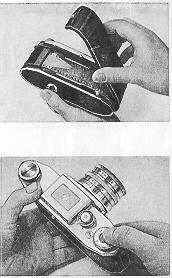 |
Make sure that the film lies evenly on the film. guide and sprocket
wheel, link the camera back into the right-hand groove and close it
down.
The film pressure-plate must be perfectly clean before the camera
back is closed.
After having bolted the camera back, make two blank exposures. The
rewind-knob (6) must hereby turn in the opposite direction of the arrow
mark.
When all these manipulations have been performed, the counting
mechanism has to be set to stroke No. 1.
The camera is now ready for the first exposure.
|
II. Changing the film
 |
36 exposures having been made, a certain ret sistance will be noticed in
winding the shutter a sign that the whole film is exposed and has to be
rewound into the cartridge.
This is done by pressing down the little button No. 13 and at the
same time turning the rewind. knob No. 6 in the direction of the arrow.
The beginning of the film will audibly slip out of the cartridge, and
the rewinding procedure is completed.
|
The camera back must now be opened and the cartridge with the exposed film
taken out.
Do not change the film in bright sunlight, but if possible in the shade. It
is advisable, before taking the film to be processed, to deposit it in
light-tight paper or in the packing material in which it was delivered. The
new film can now be loaded as described in section I.
III. Shutter and film
transport
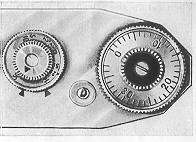 |
a) Winding the shutter
A full rotation of the knob No. 2 as far as it will go to the right
(clockwise) winds the shutter, advances the film to the next picture,
and swings the reflex mirror into the light. ray level of the lens. Take
care that the release knob No. 1 is not pressed in while the shutter is
being wound up.
|
b) Setting the speeds
The speeds are set by means of the adjusting knob No. 4 and the supplementary
knob No. 5. The speed disc is engraved with black figures for the short speeds
from 1/500th to 1/25th second, with red figures for the long speeds from
1/10th to 1/2 second, and with "B" setting for time exposures of any desired
length.
When set to the speeds of 1/500th to 1/25th second, the red triangle on the
supplementary knob No. 5 must point towards the black triangle on the camera
top.
When set to the speeds of 1/10th to 1/2 second, the red triangle on the
supplementary knob must point to the red triangle on the camera top.
The "B" setting can be employed in both positions.
To set the speeds, lift the outer ring No. 4, turn it to the desired number
and click it in. There is only one rest-hole for 1/2 and 1/25th second, marked
by a dot between the speed numbers 1/2 and 1/25.
c) Releasing the shutter
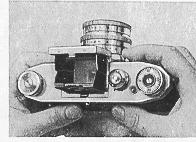 |
The exposure is made by gently pressing in the button No. 1. In order to
avoid blurring the picture, the knob should not be let loose until the
shutter has run down. When set at "B", the shutter must be pressed as
long as the exposure is to last. For the use of a wire release, the knob
is provided with a thread into which the release can be screwed. A
special wire release is supplied with the camera for long time exposures
in the T.setting (e. g. in night photography).
|
IV. Lens and Shutter
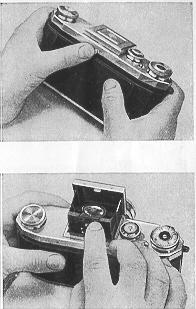 |
a) Press the button No. 12, and the light hood will
spring up, uncovering the finder lens. When the shutter is wound up, a
bright, clear picture will appear on the ground~glass surface of the
finder. By turning the distance meter ring on the lens mount, the lens
is focused to the greatest possible sharpness. Focusing should be
performed with the diaphragm set to the widest aperture, and the lens
stopped down to the desired aperture immediately before making the
exposure.
The camera is equipped with a magnifying lens for easier focusing. It
is swung into operating position by means of the lever No. 10.
When using the magnifying lens, a distance of 15 to 25 mm. between
the eye and the glass should be observed. Only then will the image on
the ground glass be perfectly clear.
|
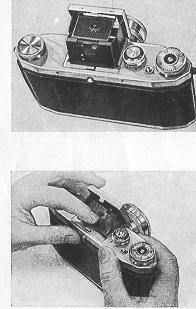 |
The direct-vision vision view finder in the light. hood is very handy
for sports snapshots.
In order to disengage this finder, the flap in the front of the
light-hood must be swung in, whereupon the magnifying lens is brought
into working position. In this way the flap is held level, and the
sports finder can be used.
To close the light-hood, first swing in the magnifying lens. Then
push in the rear flap with the forefinger and close down the light.
hood.
|
b) The Prismatic Finder
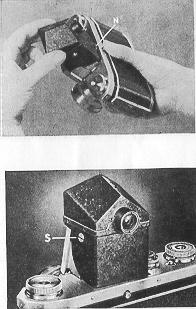 |
A Prismatic Finder is available as an accessory to the Praktiflex FX. At
eye-level, this finder gives a ground glass view of the image - upright,
correct-sided, and free from parallax error.
The Prismatic Finder is attached to the top of the camera light-hood
by fixing the nose marked "N" into the spring catch (12) of the light
hood (9) and pushing the two spring tacks marked "S" underneath the
light hood cover (9).
|
c) The lens scales
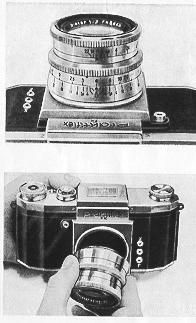 |
The front ring on the lens mount is engraved with the diaphragm scale
and the index point, the middle ring with the distance scale in meters
or feet, and the back ring with a diaphragm scale showing the depth-of
focus.
According to this scale, for instance, the Biotar lens f/2 with a
focal length of 58 mm (2 1/4"), at a distance setting of 12 ft. (4
meters) and an F/11 aperture, gives a sharpness reaching from 7 6" to 30
(2.5 to 10 meters).
|
d) Changing the lens
The lens in the camera body is interchange. able within its threaded flange.
By being turned to the left (anti-clockwise) the lens can be removed from the
camera body. Should the camera be loaded when the lens is being screwed out,
take care to shield the aperture from glaring light.
e) The mirror
The mirror is a very sensitive element in
the camera, and it must be protected even from the slightest damage. It is
advisable, before exchanging the lenses, to swing the mirror up.
Only use a very soft haired brush to remove any possible uncleanliness from
the mirror.
f) Lenses with the diaphragm-presetting device
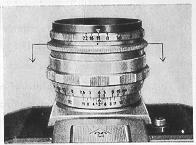 |
To preset the aperture desired for the
exposure, draw the milled ring directly behind the diaphragm scale
backward, holding the diaphragm ring - which has before been adjusted to
the desired number - with the other hand and setting the red index dot
against the diaphragm number chosen. The milled ring, when springing back
into position, will get coupled with the diaphragm ring. For focusing, the
diaphragm ring can now be set to the full aperture and, without changing
the position of the camera, turned back until it stops at the preset
diaphragm number. |
(Webmaster: These are the old preset lenses. There are still some
new long telephoto lenses being sold that work like this. Slightly newer
cameras than this model used the preset to set your shutter speed and aperture
setting with the built in meter then open wide to focus and see the image.
This preset was used to just be able to view the image and provide light to
focus)
V. Electronic and Regular Flash Connection
On the front of the camera are three contact sockets. The socket marked "X"
takes electronic flashes, whereas the "F" mark is for regular flash
synchronization.
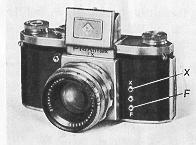 |
a) Electronic flashes (X synchronization)
To be employed for all kinds of electronic devices acting without delay.
Synchronization allows for exposures up to 1/50 th second. The central
socket is the mass contact for both flash and strobe.
b) Flash guns (F synchronization)
When using suitable flash guns, shutter speeds up to 1/500th second can
be synchronized.
|
(Webmaster: This camera can use any modern flash if it has a
PC wire. You would also need to purchase a flash holder. There are
also flash holders that have a hotshoe and PC wire, though they are usually
for professional or these types of older cameras)
The following chart gives the shortest shutter speeds in
connection with the most popular flash lamps. The flash bulb must never be put
info the flash unit before the shutter has been wound up.
THE FLASH BULB CHART
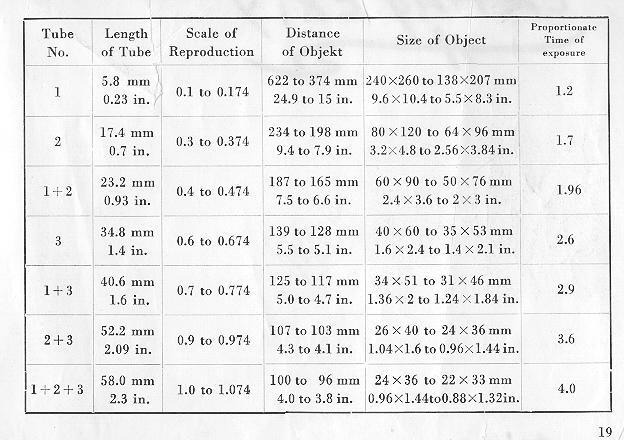
The figures in parentheses signify that synchronization is possible, but
that a certain diminution of light on one, or both, of the narrow edges of the
film has to be taken into account. This is caused by the differences existing
in the ignition and pre-ignition times.
VI. Close-up Tubes
(Macro-photography)
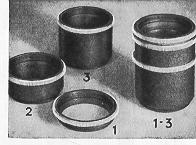 |
The lenses in the Praktiflex FX make it possible for you to approach
your object up to about 70 cm (28 in.). For exposures at shorter
distances you will have to use intermediate tubes.
The table on the next page shows the numbers and lengths of the
intermediate tubes, the distance of the object, measured from the rim of
the lens and the size of the object. also the proportionate time of
exposure.
|














